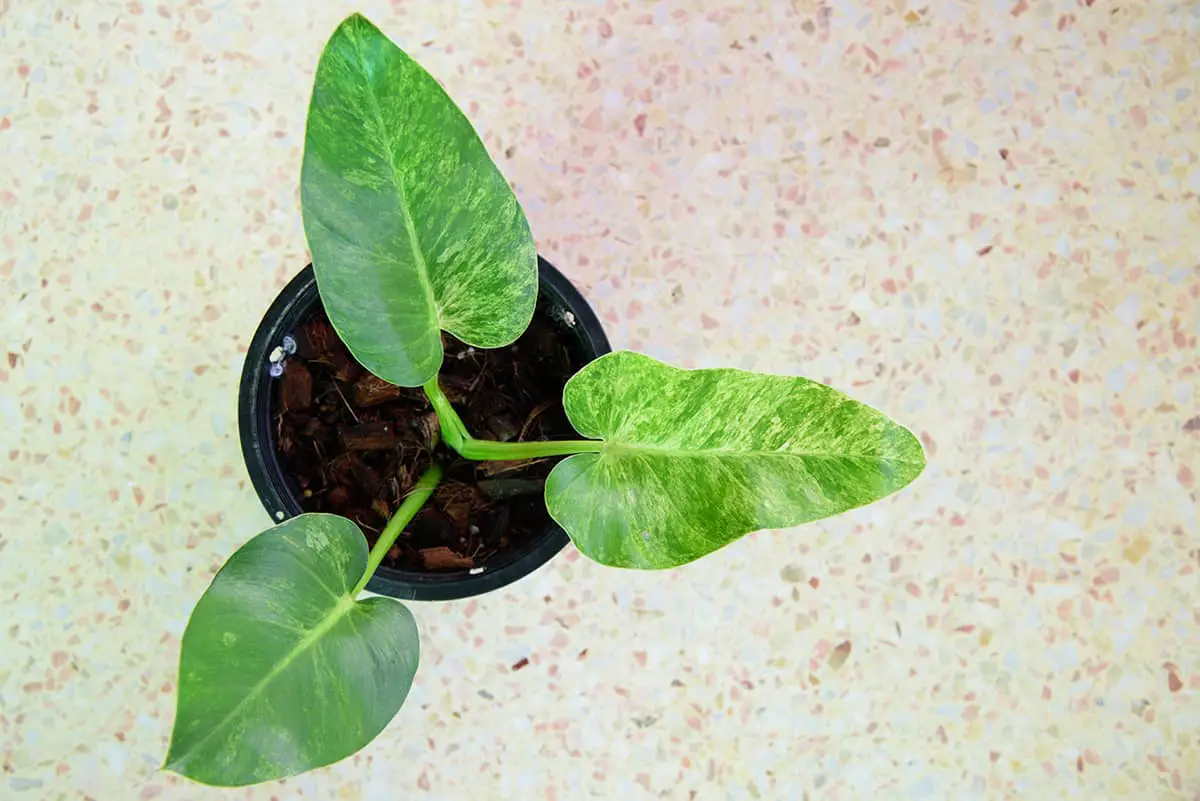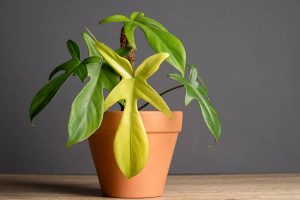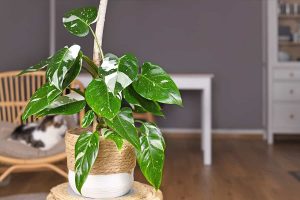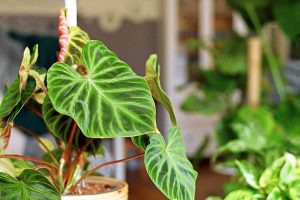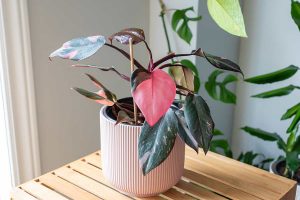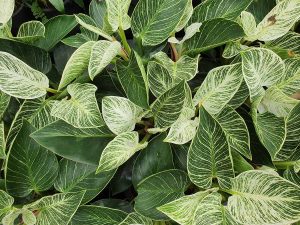As you might have guessed from its name, this species of Philodendron is gigantic. Each leaf is able to grow up to 5 feet in length at maturity and 3 feet across.
It is native to parts of South America and the Caribbean. The massive heart-shaped foliage of this plant is green and glossy and is a true sight to behold. It makes for a great feature in the garden and can also be grown as a houseplant.
| Botanical name | Philodendron Giganteum |
| Common names | Giant Philo |
| Plant family | Araceae |
| USDA hardiness zone | 9- 11 |
| Mature height | 15 feet |
| Mature spread | 8 feet |
Table of Contents
How to Care for your Philodendron Giganteum
This is a showstopper of a plant that really makes a striking impression wherever you choose to display it. For such a large and impressive species, the plant is actually surprisingly easy to care for. Here we dig into the details of ideal care conditions for your Philodendron Giganteum.
Light
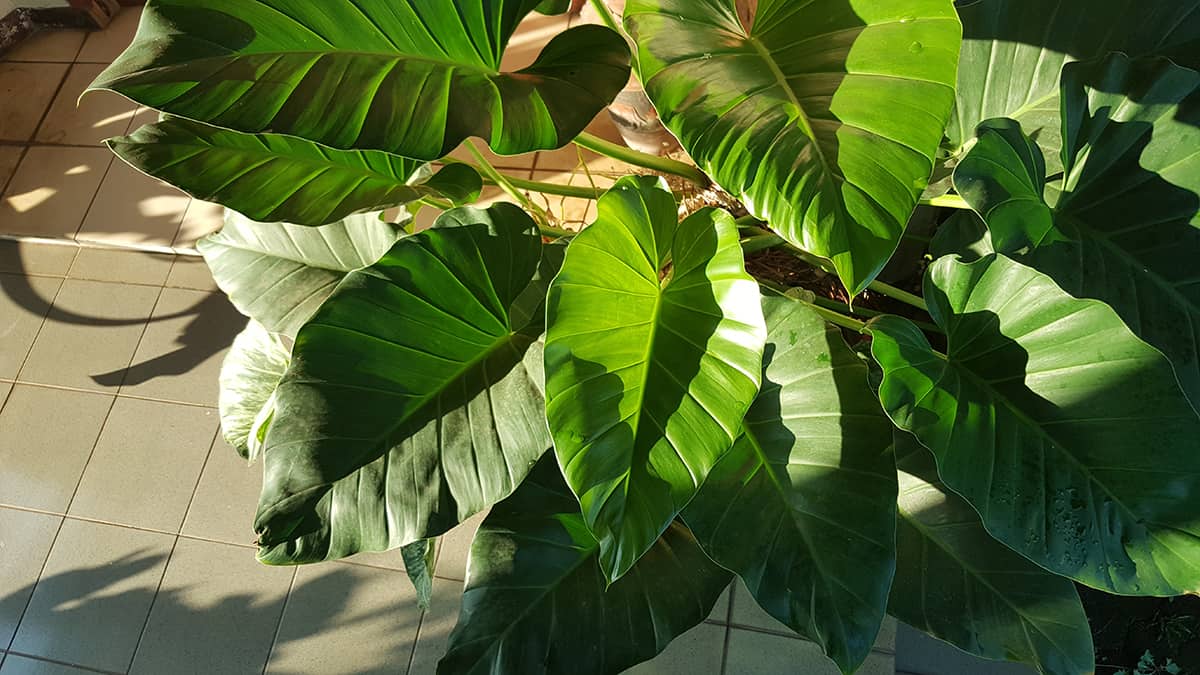
Like most Philodendrons, this plant is of tropical nature and, in its native habitat, grows beneath the shade of taller vegetation. As such, it is accustomed to dappled or filtered light.
You can mimic these conditions when growing the Philodendron Giganteum as a houseplant by positioning it in a west-facing window or several feet away from the window in a bright, south-facing room. Alternatively, you can grow this plant in a bright window if the light is filtered through blinds or a sheer curtain.
When grown outside in a garden, plant the Philodendron Giganteum beneath a taller tree for shade or in an area partially protected by a wall, fence, or other structure. The plant will also grow well under artificial fluorescent light.
Soil
The substrate a Philodendron Giganteum grows in can make a big difference to the overall health of the plant. It should be planted in a pot containing a soil mix for succulents, cacti, or orchids, which are able to hold onto a reasonable amount of water to supply moisture to the roots of the plant, but they are also very well draining.
You could make up your own mix by combining a generous amount of sand or perlite with peat and compost. It is a good idea to add small stones or wood chips to the soil mix because Philodendron Giganteum plants like to anchor themselves by wrapping their roots around small objects.
Potting
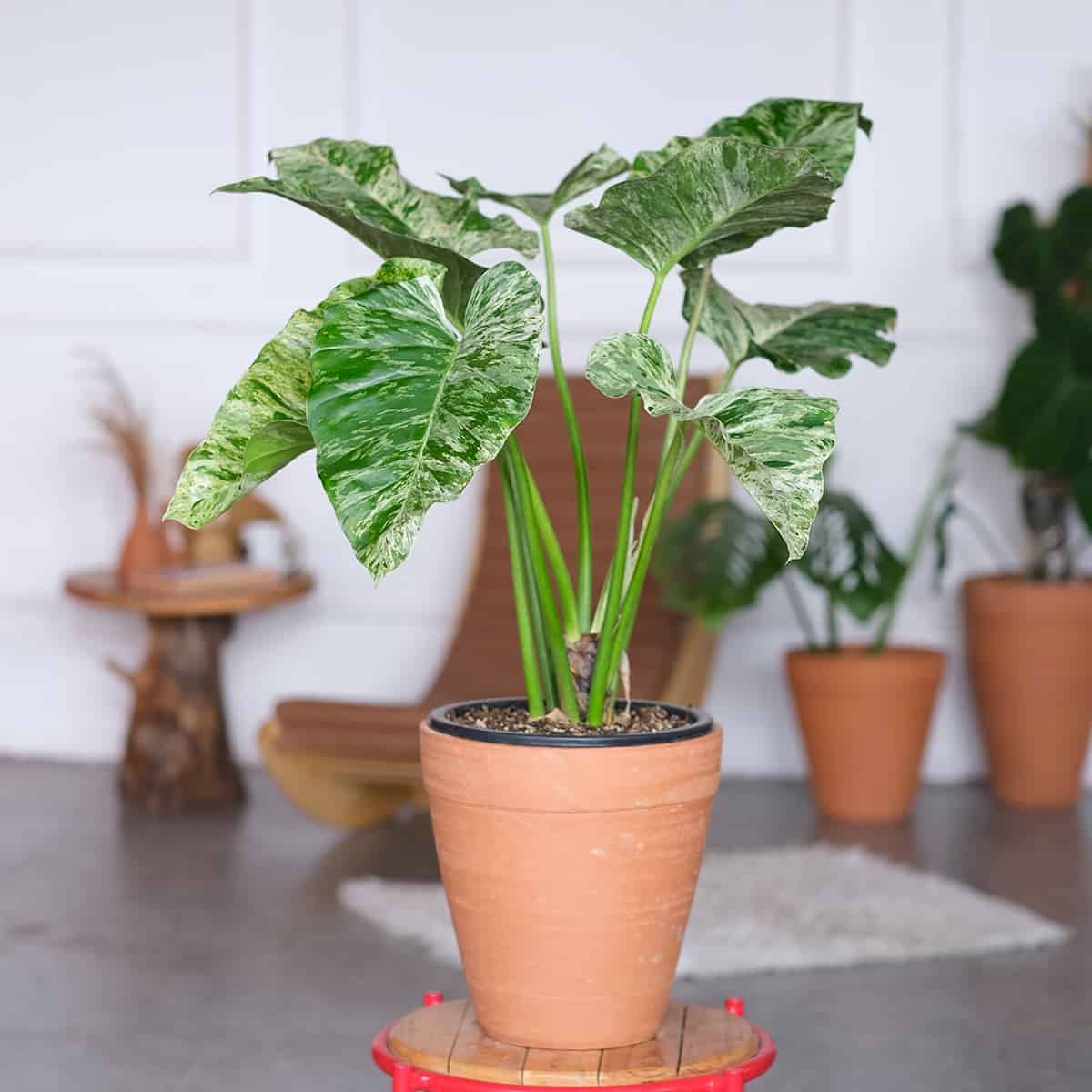
The size of pot you plant a Philodendron Giganteum in will be determined by the size of the plant, but you should, of course, bear in mind the fact that this plant can grow to be very large, and therefore it needs to be in a pot that will create stability. Philodendron
Giganteum plants grow best when they are rootbound, so you should be able to keep the plant in the same pot for a few years before it needs to be repotted. Allow the plant to remain in the original pot until the roots start to emerge out of the drainage holes or the sides of the pot feel stiff and offer no resistance when you press your hand against them.
This plant should only be repotted in spring because this gives it a chance to settle into its new pot before the period of intense growth begins in summer. If you notice that the plant feels rootbound and it is not springtime, wait until spring before you repot it, because doing this at any other time of year can cause stress to the plant that it may struggle to recover from.
Since this plant likes to be rootbound, you should only need to repot it every three years at the most. This makes it quite a low-maintenance houseplant.
Water
The Philodendron Giganteum has similar watering requirements to most other Philodendrons, so if you are used to growing plants in this genus, then you already have the experience required to ensure this plant thrives. The Philodendron Giganteum does not like to be kept in wet conditions, which is where the well-draining soil comes in because it will ensure any excess water drains away from the roots.
However, you should also help with this by avoiding providing the plant with too much water. During the growth period, you can expect to need to water your plant about once a week, while in the fall and winter, this will decrease to twice a month. The amount of water you supply at each watering will depend on the size of the plant. A good tip is to water the plant until you see water seeping out of the drainage holes at the bottom.
At this point, stop watering, and empty any excess water out of the pot after a few minutes. Although overwatering is the biggest mistake people make with houseplants, underwatering can be equally problematic. The Philodendron Giganteum does not like to be sat in dry soil, although it can survive very short periods of drought. This means that you don’t need to worry too much if you go on vacation and forget to arrange for a neighbor to water your plant, but you also shouldn’t make a habit of depriving your Philodendron Giganteum of moisture.
A Philodendron Giganteum, which undergoes frequent periods of drought, will respond with foliage that looks faded or washed out and leaves that are smaller than they should be. To avoid this, check on the condition of your plant’s soil each week, and once the top two inches of the soil have dried out, you can deliver more water to the plant. Try not to let all of the soil entirely dry out between each watering, but a few inches of dry soil is good for the plant.
Temperature
This plant grows in hot climates in its native habitat, and these need to be replicated when the Philodendron Giganteum is grown in a garden or as a houseplant. It can grow outside in USDA hardiness zones 9-11 and is ideal for keeping indoors because the average room temperature in a home is perfect for tropical plants.
The ideal temperature for this plant to grow in is between 65 and 80°F. It can survive in temperatures as low as 55°F, but consistently low temperatures will cause stunted growth.
Humidity
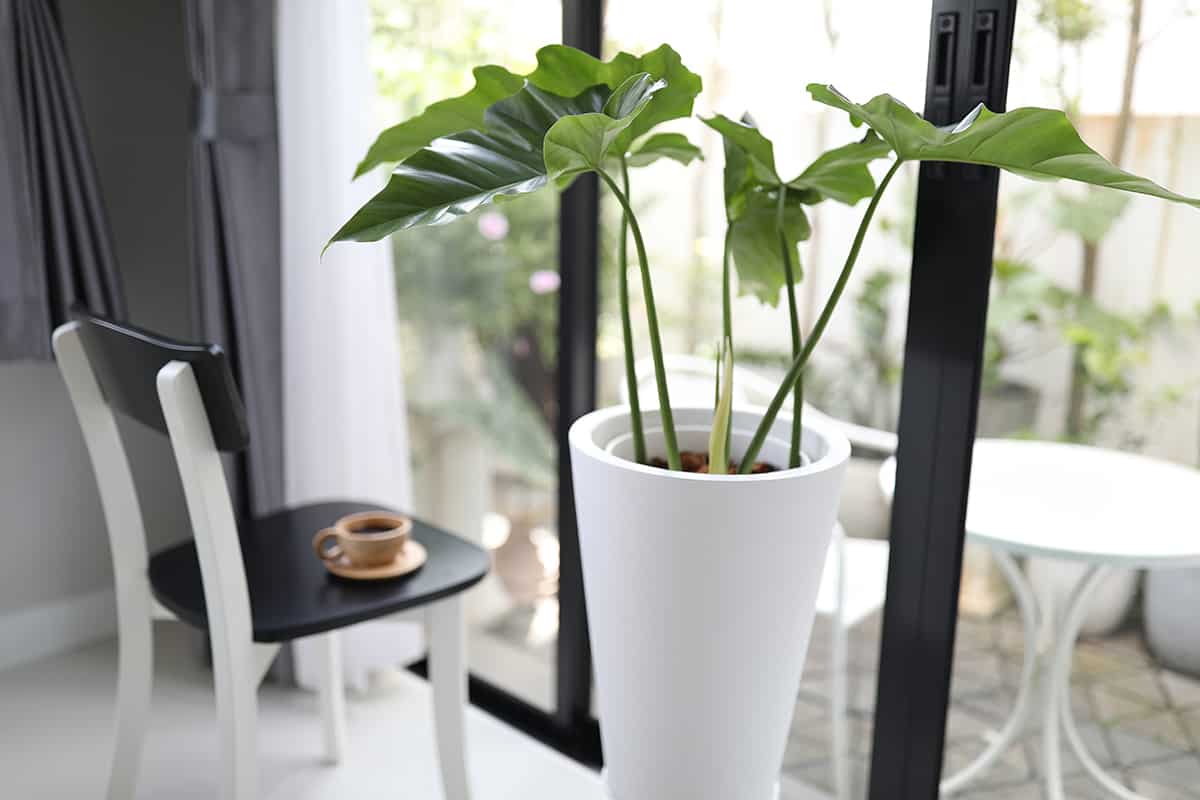
As a tropical plant, the Philodendron Giganteum enjoys high levels of humidity. To help the plant thrive and maintain a lush appearance, aim for a consistent humidity level of around 60%. Typical indoor humidity in homes is around 30%, so you will need to take steps to increase the humidity for this plant.
If you have enough space, it will love being kept in a bathroom where humidity is generally higher. Otherwise, you can spritz the plant’s leaves with a water spray or use a pebble tray. You can also wipe down the foliage with a wet sponge, which will remove any dirt or dust from the leaves while also helping to provide some extra moisture in the air around the plant.
Fertilizer
The Philodendron Giganteum is known for sucking all of the nutrients out of soil quite rapidly, so if you want this plant to continue thriving, then you’ll need to replace these nutrients with fertilizer. This becomes more important as the plant comes to the end of its life in its current pot because soil that has been growing a plant for many years will be devoid of nutrients.
During spring and summer, add a liquid fertilizer for houseplants to your watering schedule, but do not use any fertilizer at all during fall and winter. You could also use an all-purpose fertilizer that has been diluted.
Philodendron Giganteum FAQ’s
How big is a Philodendron Giganteum?
This plant produces giant leaves, but the actual plant itself doesn’t grow to be as big as you might expect. In the wild, the Philodendron Giganteum will reach heights of between 12 and 15 feet when mature, but when grown as a houseplant, it rarely grows taller than 4 feet.
In terms of spread, in the wild, the Philodendron Giganteum can grow to between 6 and 8 feet wide, but this figure will be closer to 3 feet when the plant is grown indoors. Each leaf of this plant can grow to a maximum of 5 feet long in its native habitat, but as a houseplant, mature leaves will be 2 feet long.
Can Philodendron Giganteum live outside?
Yes, the Philodendron Giganteum can live outside in warm climates. If you live in USDA hardiness zones 9-11, you can plant this Philodendron directly in your backyard or in an outdoor planter, where it will happily grow all year round.
Are Philodendron Giganteum easy to grow?
This plant is easy to grow as long as you have enough space to accommodate it. It is a monster of a plant that is fairly low maintenance in terms of care, but it can be difficult to find new spots for it when the size exceeds its current position.
